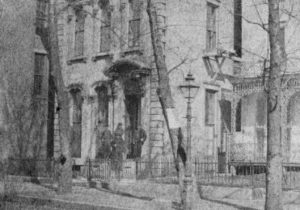 “As today marks the first day of Black History Month, we are celebrating with the story of the Three Thomases. This narrative looks back at Louisville Water’s history (dating back to the late 1800s) and our relationship with three black employees who happen to have more than their name in common. We are humbled to look back on the archives and honor the first Black employees at Louisville Water.”
“As today marks the first day of Black History Month, we are celebrating with the story of the Three Thomases. This narrative looks back at Louisville Water’s history (dating back to the late 1800s) and our relationship with three black employees who happen to have more than their name in common. We are humbled to look back on the archives and honor the first Black employees at Louisville Water.”
James H. Thomas. James W. Thomas. Thomas L. Thomas. All are just names.
When exploring Louisville Water’s early employee history, you’ll find a complex and sometimes difficult-to-connect web of human interactions. Existing records from Louisville Water’s early days (dating back as far as 1854), tell little about individual employees. Much of this information was lost over time.
The earliest documented African-Americans on Louisville Water’s payroll were the three Thomases. From the late 19th and into the early 20th centuries, a bit of the Thomas family history can be recounted. They appear to be related; possibly father and sons. Familial generations of workers are common throughout Louisville Water’s history and the Thomases were no different.
James H. appears to be the first and longest serving of the Thomases. He began his career in 1872 as a porter, moved into a messenger role, and then transitioned in 1876 into the position of on-off man. Eventually, he became the first on-off man in 1900. He later switched positions once again to become the Second Floor Porter until he departed for unknown reasons in 1905.
James W. only worked at the company for a few years in the late 1870s as a laborer and teamster. Later in 1882, Thomas L. Thomas began working as porter or janitor. He ended up staying in this role for the next 17 years.
It is not much but knowing where they lived fills in a few more details. Both James H. and James W. lived for a few years on Center Street, now Armory Place, near Chestnut Street — just a few blocks away from company headquarters. James H. then moved in the 1890s to live behind the livery stable that once stood on the site of 1910 office building. He shared this residence with Thomas. Theirs, with a small front porch, was one of the four connected brick tenements buildings that were on the lot adjoining Louisville Water’s offices. Thomas later moved to a small one-story wooden building behind a still existing shotgun house on W. Madison between 27th and 28th streets.
In 1881, the board voted to give $30 to pay for funeral expenses to bury James Thomas for his “long and faithful services” because of the “poverty of the family.” Some members of the Thomas family are buried at Eastern Cemetery on Baxter Avenue.

If so little is known, then why share the story at all?
While we acknowledge the shortcomings of our historical archives, every story has a starting point and the Thomases represent the beginning of ours. They represent real people, relatable experiences, and our ever-evolving community. Each person’s history is one more puzzle piece that helps tells the story of how we all came to be.
Perhaps at some time in the future more about the Thomases and the lives they lived will be revealed.

